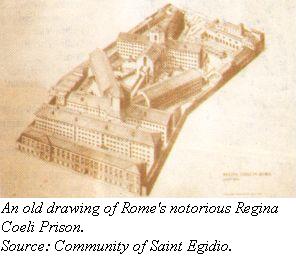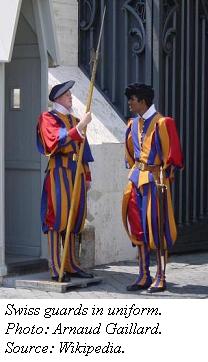Monsignor Hugh O'Flaherty
"God's Traveler."
 The war was preventing the Holy Office from doing its usual business. So it was decided that the Office should be in charge of an organization to collect information and news on prisoners-of-war and refugees. One Msgr. Bergoncini Duca was appointed to be the Pope’s messenger to the many Allied POW camps scattered throughout Northern Italy. Tagging along as secretary and interpreter was Hugh O’Flaherty.
The war was preventing the Holy Office from doing its usual business. So it was decided that the Office should be in charge of an organization to collect information and news on prisoners-of-war and refugees. One Msgr. Bergoncini Duca was appointed to be the Pope’s messenger to the many Allied POW camps scattered throughout Northern Italy. Tagging along as secretary and interpreter was Hugh O’Flaherty.They started their tour of the camps on Easter, 1941. Msgr. Duca’s style was to set a stately pace, inspecting one camp a day, spending the nights at hotels. O’Flaherty’s style was to spend hours talking with the prisoners, then at night, travel back to Rome by rail. There he could use the Vatican’s radio station to announce names and messages from the prisoners he had visited with, so their families would know they were alive. Then he would rush back to join Duca at another camp.
Somewhere O’Flaherty also found the time to arrange for warm clothing to be delivered to the camps in time for the cold Northern Italian winter. He collected and distributed an estimated ten thousand books for the prisoners – and didn’t let official camp censors stand in his way. When bureaucracy held up the delivery of Red Cross packages, O’Flaherty blatantly cut through red tape and regulations until the parcels reached the prisoners. The camps at Modena and Piacenza were very badly run; with a word in the right ear, O’Flaherty managed to get both camps’ commandants fired.
So good was O’Flaherty at his work that, as J.P. Gallagher writes, “the Italian Government decided it was time this pest was kept out of their POW camps.” Bureaucratic pressure was brought to bear Vatican officials. By Christmas 1942, O’Flaherty was instructed to resign his work in the camps. In obedience to his superiors, the monsignor returned to Rome.
The First Rescues.
We don’t know if O’Flaherty felt hurt by this order to resign. But as it turned out, it was a good thing he came back to Rome when he did. Mussolini and the Germans were beginning to crack down on those Roman citizens they felt were dangerous or undesirable. Their targets included prominent Jews, well-known anti-Fascists, and Italian aristocrats who did not support the regime. O’Flaherty knew many of these people. They were the society he had socialized with before the war. And when they found themselves in danger, it’s not surprising that one of the first persons they thought of turning to was the Irish priest.O’Flaherty began by hiding people in the homes of some of his friends in Rome. Others he sent to monasteries or convents. As the Fascist raids became more dangerous, O’Flaherty began bringing people into the Vatican and lodging them in his own residence, a building ironically known as the “German College,” because it had traditionally housed German religious scholars.
 There was another group that knew O’Flaherty and was inclined to come to him for help: prisoners-of-war who had met the priest during his visits to the camps. Any POWs who managed to escape tended to head for Rome, in search of the British embassy. St. Peter’s Basilica was an inviting destination too; surely the church had to offer safety and shelter to anyone who asked?
There was another group that knew O’Flaherty and was inclined to come to him for help: prisoners-of-war who had met the priest during his visits to the camps. Any POWs who managed to escape tended to head for Rome, in search of the British embassy. St. Peter’s Basilica was an inviting destination too; surely the church had to offer safety and shelter to anyone who asked?
The Vatican was doing what it could. For example, some 477 Jews were sheltered in the Vatican during the war. But 0.44 square kilometers can only hold so many people, and the Nazis were keeping a close eye on Vatican activity. The Swiss Guard, the Vatican’s police force, was ordered to turn asylum-seekers away. One such group of British escapers was standing bewildered in the middle of St. Peter’s Square when someone brought them to O’Flaherty’s attention. The Irishman arranged to have them hidden in the barracks of a friendly Italian police brigade. It was all in a day’s good work for O’Flaherty. He probably had no idea what he was starting.